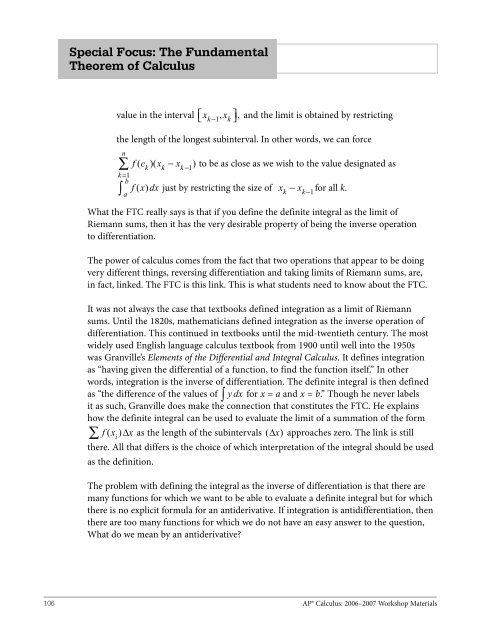AP Calculus
Calculus_SF_Theorem
Calculus_SF_Theorem
Create successful ePaper yourself
Turn your PDF publications into a flip-book with our unique Google optimized e-Paper software.
Special Focus: The Fundamental<br />
Theorem of <strong>Calculus</strong><br />
value in the interval ⎡⎣ x<br />
k −<br />
1<br />
, x ⎤<br />
k ⎦ , and the limit is obtained by restricting<br />
the length of the longest subinterval. In other words, we can force<br />
n<br />
∑<br />
k = 1<br />
b<br />
f ( c )( x − x ) to be as close as we wish to the value designated as<br />
k<br />
k<br />
k −1 ∫ f ( x)<br />
dx just by restricting the size of xk<br />
x<br />
a<br />
−<br />
k −1<br />
for all k.<br />
What the FTC really says is that if you define the definite integral as the limit of<br />
Riemann sums, then it has the very desirable property of being the inverse operation<br />
to differentiation.<br />
The power of calculus comes from the fact that two operations that appear to be doing<br />
very different things, reversing differentiation and taking limits of Riemann sums, are,<br />
in fact, linked. The FTC is this link. This is what students need to know about the FTC.<br />
It was not always the case that textbooks defined integration as a limit of Riemann<br />
sums. Until the 1820s, mathematicians defined integration as the inverse operation of<br />
differentiation. This continued in textbooks until the mid-twentieth century. The most<br />
widely used English language calculus textbook from 1900 until well into the 1950s<br />
was Granville’s Elements of the Differential and Integral <strong>Calculus</strong>. It defines integration<br />
as “having given the differential of a function, to find the function itself.” In other<br />
words, integration is the inverse of differentiation. The definite integral is then defined<br />
as “the difference of the values of ∫ y dx for x = a and x = b.” Though he never labels<br />
it as such, Granville does make the connection that constitutes the FTC. He explains<br />
how the definite integral can be used to evaluate the limit of a summation of the form<br />
∑ f ( xi)<br />
∆ x as the length of the subintervals ( ∆x ) approaches zero. The link is still<br />
there. All that differs is the choice of which interpretation of the integral should be used<br />
as the definition.<br />
The problem with defining the integral as the inverse of differentiation is that there are<br />
many functions for which we want to be able to evaluate a definite integral but for which<br />
there is no explicit formula for an antiderivative. If integration is antidifferentiation, then<br />
there are too many functions for which we do not have an easy answer to the question,<br />
What do we mean by an antiderivative?<br />
106<br />
<strong>AP</strong>® <strong>Calculus</strong>: 2006–2007 Workshop Materials


